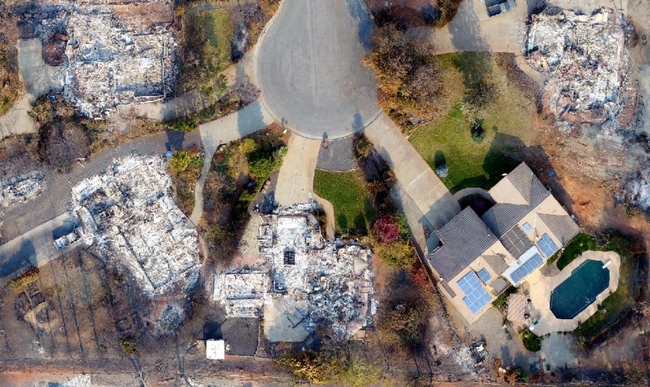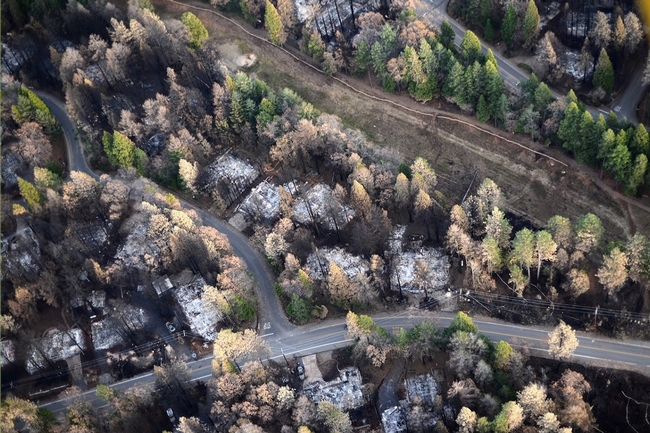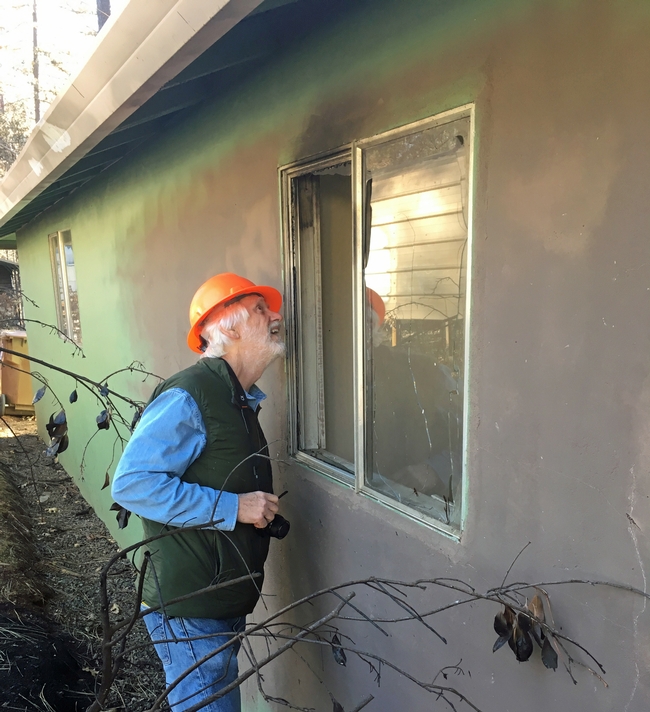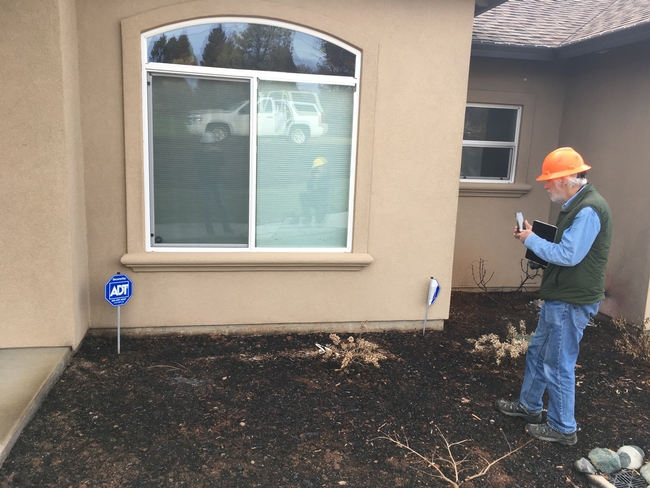Can homes be designed to withstand wildfire?
[This story was originally published Oct. 4, 2021, and updated Dec. 21, 2022]
In 2018, the Camp Fire destroyed nearly 19,000 structures in Northern California, including most of the town of Paradise. The structures left standing by the conflagration provided researchers an opportunity to investigate how housing arrangement – such as the size of the lot, the distance to a neighboring home, and surrounding vegetation – influenced which homes survived. They also looked at whether changes to the California Building Code in 2008, through the addition of Chapter 7A, improved the chances of homes built in the wildland-urban interface to withstand wildfire.
Both housing arrangement and surrounding vegetation likely influenced the survival of homes during an extreme wildfire, according to new research from the USDA Forest Service and the University of California Agriculture and Natural Resources analyzing the Camp Fire aftermath, which will be published Oct. 3 in the journal Fire Ecology.
“Our team found a reason for hope and information that can help Californians, building contractors and policymakers better prepare for future fires,” said co-author Yana Valachovic, University of California Cooperative Extension forest advisor.
The 2008 code, which applied to the city of Paradise, requires the installation of vents that resist flames and embers and other elements that help harden a home to wildfire. This chapter of the California Building Code added requirements for construction materials to California's existing two-zone fuel and vegetation modification guidance, known as “defensible space,” which applies to the vegetation and fuels out to 100 feet from a home.
The researchers found that the age of the home was a significant factor in predicting survival. But the key year wasn't 2008. Improvements in performance happened earlier. Only 11% of single-family homes built in or before 1996 survived, compared with 40% for homes built after 1996. Older homes were, on average, placed closer together and had more overstory tree growth near the home. Overall, the greater the distance between structures, the lower the likelihood of a home being destroyed by the Camp Fire. And the less overstory tree canopy cover, the higher the likelihood of a home surviving.
During a wildfire, structures can be threatened by the flaming front of the fire and by embers that are lofted ahead of the fire and land on fuels such as vegetation or mulch next to the house, igniting new fires. Embers can also enter homes through open windows or vents. Heat radiating from adjacent burning buildings or vegetation can also impact home survival.
In 2022, during a visit to Laguna Niguel after the Coastal Fire, Valachovic saw that defensible space had prevented flames from reaching homes. However, some houses had burned from the inside out after embers penetrated attic vents and ignited combustible materials.
“Despite the unpredictable nature of wildfire, strong associations with home arrangement and overstory vegetation cover indicate home survival is at least somewhat predictable,” said lead author Eric Knapp of the USDA Forest Service. “The silver lining is that this also suggests steps can be taken to substantially improve the odds of homes surviving a wildfire.”
One of the biggest drivers of home loss in the Camp Fire was the heat radiating from the large number of structures that burned. Over 73% of homes destroyed in Paradise had a structure burn within 59 feet. The distance to the nearest destroyed structure or total number of destroyed structures within 328 feet was a primary predictor of home loss.
“Exposure to the heat of a nearby burning structure can break glass in a window, for example. Once the glass is broken, embers or flames can enter the house,” said co-author Steve Quarles, emeritus UC Cooperative Extension advisor and retired chief scientist for the Insurance Institute for Building & Home Safety.
This finding suggests that denser developments, built to the highest standards, may protect subdivisions against radiant heat from a vegetation fire, but density may become a detriment once buildings ignite and radiant heat loads increase as well as the increased potential for direct flame contact.
“This research suggests a strong neighborhood effect, where the condition and proximity of an outbuilding or a neighbor's home can have a significant influence on a building's survival given the radiant heat exposure from a neighboring building burning,” Valachovic said.
Tree canopy cover was also associated with home loss, with a higher probability of home survival where tree cover was moderate or less.
“Trees provide shade, which is important where summers are hot. But to have the amenities trees provide without undue fire hazard, the key is to clean up the leaves and dead wood trees produce,” said Knapp. “This includes keeping roofs, gutters, garden beds adjacent to the structure and spaces under attached decks, free of leaves.”
The researchers detected no significant increase in survival for homes built from 2008 to 2018, under the new building code, compared to homes constructed during an equal time period, 1997 to 2007, immediately preceding the adoption of the new code. Houses built during the last two decades resisted wildfire better than older homes, indicating an overall improvement in common construction standards and the performance of building materials.
“It is important for Californians to understand that homes and immediate surroundings need to be well-maintained to resist embers, survive extended radiant heat exposures and minimize direct flame contact,” Quarles said. “Fortunately, all building codes get better with time and Chapter 7A is no exception – Californians have benefited from it. California's Building Code is reviewed every three years, and it is evolving as new knowledge becomes available based on research and post-fire assessments.”
To enhance wildfire protection at the neighborhood scale, the researchers recommend coordinating efforts with neighbors.
“Because ember ignition of one house can put neighboring houses at risk, it is critical that fuel reduction happens at a community scale. Living with fire means doing all things possible to prevent one's house from catching fire,” said Valachovic.
There are simple actions that homeowners can take to protect their homes.
“From retrofitting with vents that resist ember entry or using tempered glass windows, to the simple things, like not placing bark mulch or woody plants next to homes, and using gutter guards to minimize leaf and needle accumulation in gutters, all will improve the chance of home survival,” Quarles noted. “It is a matter of how we choose to live in this environment.”
“Housing arrangement and vegetation factors associated with single-family home survival in the 2018 Camp Fire, California” by Knapp, Valachovic, Quarles and Nels G. Johnson is published in the journal Fire Ecology at https://fireecology.springeropen.com/articles/10.1186/s42408-021-00117-0.
For more information:
- Steps for hardening houses against wildfire can also be found at the Fire in California website: https://ucanr.edu/sites/fire/Prepare/Building.
- Reducing the vulnerability to buildings to wildfire: vegetation and landscape guidance https://anrcatalog.ucanr.edu/pdf/8695.pdf





Thanks
Posted by Jeremy on October 7, 2021 at 8:39 AM